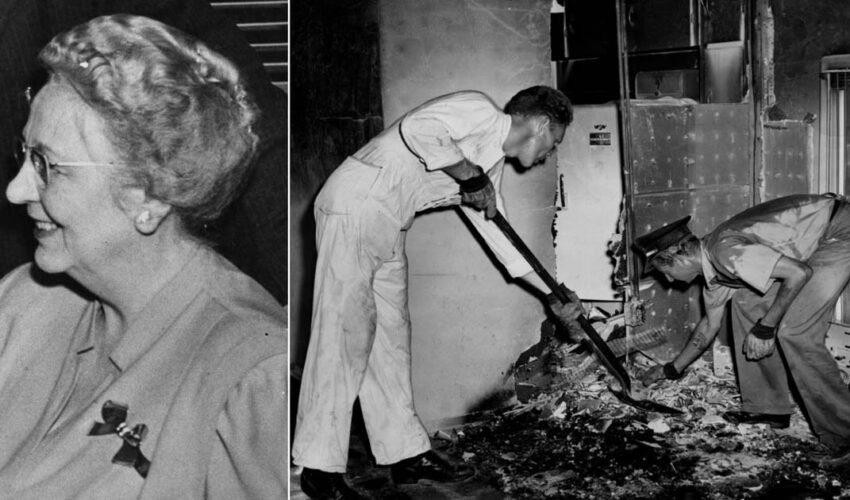Pansy Carpenter, Reeser’s landlady, dropped by her apartment on July 2, 1951, to deliver a telegram. Nobody answered the door when Carpenter arrived. She put her hand on the doorknob and discovered it to be unusually hot, so she dialed 911.

When police arrived at the apartment at 1200 Cherry Street, they discovered 67-year-old Mary Reeser dead in a mysterious fire. According to reports, her body was disintegrated by a “white-hot intensity” blaze.
Except for her leg, Mary Reeser’s human body was completely transformed into ash when police discovered her, but the rest of her apartment miraculously remained intact. Mary Reeser’s death was allegedly caused by spontaneous human combustion.
Who was Mary Reeser?
Mary Reeser was born in Columbia, Pennsylvania on March 8, 1884. After her husband died, she relocated to St. Petersburg, Florida, to be closer to her adult son, Richard, and his family. Mary had been complaining about the hot weather in Florida. She was also a smoker who took sleeping pills on a regular basis.
The day before her death, she expressed her concerns to Richard about a trip she had planned to take back to Pennsylvania. She had been looking forward to getting away from the Florida heat and was worried that the trip would be cancelled. It was cruelly ironic that the telegram that led to the discovery of Mary’s remains came from a friend in Pennsylvania informing her that the trip had been planned and organised.
What happened on the night of Mary Resser’s Combustion
Reeser’s remains, mostly ashes, were discovered among the ruins of a chair in which she had been sitting. Only a portion of her left foot (which was wearing a slipper) and her backbone, as well as her skull, remained. Plastic household objects located a safe distance from the fire had softened and lost their shape.

The death of Mary Reeser shocked authorities because cremation takes three to four hours at temperatures around 3,000 degrees Fahrenheit. It was shocking considering other things around her remained intact, and her body burnt at 3,000 degrees Fahrenheit.
When the officials arrived, the apartment was very warm, and the majority of it was still intact. The object near Resser’s chair had softened and lost shape, but the rest of the room appeared to be unaffected by the flame that had engulfed Mary Reeser.
J. R. Reichert, the chief of police in St. Petersburg at the time, sent a box of evidence from the scene to FBI Director J. Edgar Hoover on July 7, 1951. Glass shards discovered in the ashes, six “small objects thought to be teeth,” a section of the carpet, and the surviving shoe were among the items he included.
According to her daughter-in-law “The cigarette fell to her lap. Her fat served as the fuel that kept her going. The floor was concrete, and the chair was alone. There was nothing to burn around her “.
The FBI eventually concluded that Reeser was killed by the wick effect. They assumed she had fallen unconscious while smoking and set fire to her nightclothes because she was a known user of sleeping pills. “Once the body begins to burn,” the FBI wrote in its report, “there is enough fat and other flammable substances to allow for varying degrees of destruction.” This destruction by burning can sometimes progress to the point where the body is almost completely consumed by fire.”
Because of the case’s ambiguous circumstances, it’s been speculated that Reeser died as a result of spontaneous human combustion. When a person bursts into flames as a result of a chemical reaction in their body, there is no apparent ignition of an external heat source. Despite the fact that there have been reports of alleged human combustion since 1663, not all scientists are convinced.
Dr. Wilton M. Krogman, an experienced fire researcher, and professor of physical anthropology at the University of Pennsylvania disagreed with the FBI’s conclusion. “I cannot conceive of such complete cremation without more burning of the apartment,” Krogman wrote of all the fire deaths he had investigated.
Mary Reeser passed away nearly 70 years ago. So, was it a case of unintentional human combustion? Given the length of time since her death, it appears unlikely that the true cause will ever be discovered.
Now that you’ve read about Mary Reeser, read about the case of Camel girl.












Follow Us